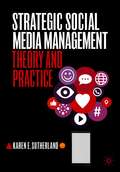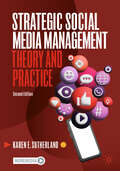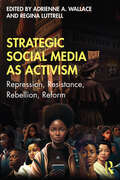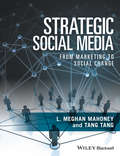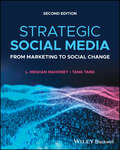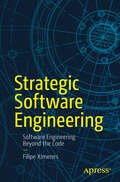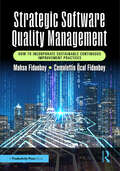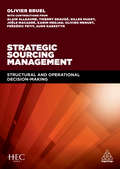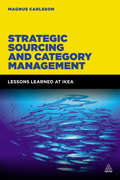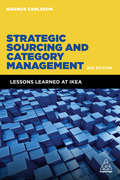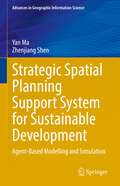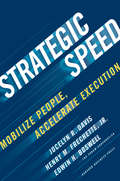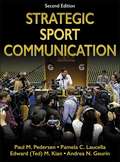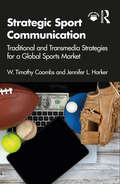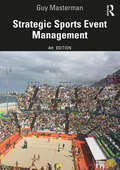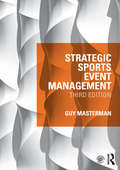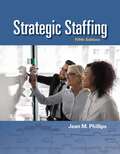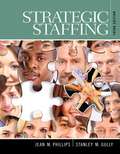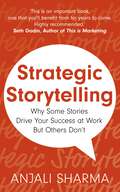- Table View
- List View
Strategic Social Media Management: Theory and Practice
by Karen E. SutherlandThis textbook provides a lively introduction to the fast-paced and multi-faceted discipline of social media management with international examples and perspectives. Aside from focusing on practical application of marketing strategy, the textbook also takes students through the process of strategy development, ethical and accurate content curation, and strategy implementation, through detailed explanations of content creation.Combining theory and practice, Strategic Social Media Management teaches students how to take a strategic approach to social media from an organisational and business perspective, and how to measure results. Richly supported by robust and engaging pedagogy and cases in each chapter, it integrates perspectives from public relations, marketing and advertising, and examines key topics such as risk, ethics, privacy, consent, copyright issues, and crises management. It also provides dedicated coverage of content strategy and campaign planning and execution.Reflecting the demands of contemporary practice, advice on self-care for social media management is also offered, helping to protect people in this emerging profession from the negativity that they can experience online when managing an organisation’s social media presence. After reading this textbook, students will be able to develop a social media strategy, curate accurate and relevant content, and create engaging social media content that tells compelling stories, connects with target audiences and supports strategic goals and objectives.This is an ideal textbook for students studying social media strategy, marketing and management at undergraduate level. It will also be essential reading for marketing, public relations, advertising and communications professionals looking to hone their social media skills and strategies.
Strategic Social Media Management: Theory and Practice
by Karen E. SutherlandThis textbook provides a lively introduction to the fast-paced and multi-faceted discipline of social media management, with international perspectives, AI approaches and tools to enhance the learning experience. Aside from focusing on practical application, the textbook takes readers through the process of strategy development and implementation, ethical and accurate content curation, and strategic content creation.Combining theory and practice, Strategic Social Media Management teaches readers how to take a strategic approach to social media from organisational and business perspectives, and how to measure results. Richly supported by robust and engaging pedagogy and case studies, it integrates public relations, marketing and advertising perspectives, and examines key issues including risk, ethics, privacy, consent, copyright, and crisis management.Reflecting the demands of contemporary practice, advice on self-care is also provided, helping to protect emerging Social Media Managers from the negativity they can experience online. By the end, readers will be able to develop a social media strategy, understand accurate and relevant content curation, and create engaging social media content that tells compelling stories, connects with target audiences and supports strategic goals and objectives.This is an ideal textbook for students learning social media strategy, marketing and management at undergraduate level. It is also essential reading for business owners, marketing, public relations, advertising and communications professionals looking to hone their social media skills.The first edition of this textbook won a Book Excellence Award, a Silver International Stevie Award for Best Business Book and was named in the Best 100 Public Relations eBooks of All Time by the Book Authority.
Strategic Social Media as Activism: Repression, Resistance, Rebellion, Reform
by Adrienne A. Wallace and Regina LuttrellDrawing on a range of theoretical and empirical perspectives, this volume examines the roles strategic communications play in creating social media messaging campaigns designed to engage in digital activism. As social activism and engagement continue to rise, individuals have an opportunity to use their agency as creators and consumers to explore issues of identity, diversity, justice, and action through digital activism. This edited volume situates activism and social justice historically and draws parallels to the work of activists in today’s social movements such as modern-day feminism, Black Lives Matter, #MeToo, Missing Murdered Indigenous Women, and We Are All Khaled Said. Each chapter adds an additional filter of nuance, building a complete account of mounting issues through social media movements and at the same time scaffolding the complicated nature of digital collective action. The book will be a useful supplement to courses in public relations, journalism, social media, sociology, political science, diversity, digital activism, and mass communication at both the undergraduate and graduate level.
Strategic Social Media: From Marketing to Social Change
by Tang Tang L. Meghan MahoneyStrategic Social Media is the first textbook to go beyond the marketing plans and how-to guides, and provide an overview of the theories, action plans, and case studies necessary for teaching students and readers about utilizing social media to meet marketing goals. Explores the best marketing practices for reaching business goals, while also providing strategies that students/readers can apply to any past, present or future social media platform Provides comprehensive treatment of social media in five distinct sections: landscape, messages, marketing and business models, social change, and the future Emphasizes social responsibility and ethics, and how this relates to capitalizing on market share Highlights marketing strategies grounded in research that explains how practitioners can influence audience behaviour Each chapter introduces theory, practice, action plans, and case studies to teach students the power and positive possibilities that social media hold
Strategic Social Media: From Marketing to Social Change
by Tang Tang L. Meghan MahoneyLearn to utilize social media strategies that inspire behavior change in any landscape Strategic Social Media: From Marketing to Social Change, Second Edition combines best social media marketing practices with the application of traditional communication, behavior change, and marketing theories. More than a basic "how-to" guide, this innovative resource balances social media theory and real-world practice in a variety of areas, including advocacy, public health, entertainment, and education. With a clear and readable style, the authors explain the power and possibilities of social media to influence personal relationships and social change. The media environment of today is more mobile, visual, and personalized than ever before. In the second edition of Strategic Social Media, the authors incorporate advances in the field such as enhanced visual communication, digital experience sharing, omnichannel marketing, IoT, artificial intelligence, mass personalization, and social e-commerce. An entirely new chapter on utilizing social media for personal branding efforts is accompanied by new and updated examples, action plans, business models, and international case studies throughout. Covers all key aspects of strategic social media: landscape, messages, marketing and business models, social change, and the future Highlights opportunities to break down barriers with institutions of power, achieve greater transparency, and mobilize users through social media Contains social media strategies readers can apply to any past, present, or future social media platform Helps practitioners make better decisions about brand objectives and evaluate and monitor social media marketing efforts Provides clear guidance on crafting social media messages that reach intended audiences and ignite dialogue and behavior change Offering comprehensive coverage of both the theory and practice of facilitating behavior change in social media audiences, Strategic Social Media: From Marketing to Social Change, Second Edition, is essential reading for undergraduate and graduate students in digital and social media marketing courses, social media practitioners, entrepreneurs, digital content creators, journalists, activists, and marketing and public relations professionals.
Strategic Software Engineering: Software Engineering Beyond the Code
by Filipe XimenesThe role of a software engineer goes well beyond writing code. In many companies, large or small, engineers often need to understand unfamiliar business rules, and then coordinate with multiple groups to ship software within a tight schedule. Although the skills required to perform this job effectively can be hidden within one's years of experience, learning from mistakes, peer guidance, and available resources, are critical to success. This book summarizes the skills and practices effective engineers should leverage to excel at their job. A chapter is dedicated to each of the four main pillars that form a successful engineering career: Self-Management, Technical Discipline, Risk Management, and Strategic Teamwork. Topics covered within each pillar include insights and tips on how to enhance your career simply by making small changes in the way you work. Based on a collection of mentorship sessions from author Filipe Ximenes, Strategic Software Engineering will empower you to maximize the impact of your work. What You Will Learn Master skills beyond writing code to achieve career goals. Make your day-to day work more impactful through meaningful changes. Identify, mitigate, and manage risk. Leverage teamwork and collaboration to build successful products. Who This Book Is For Mid-level engineers looking to make the jump to senior roles, as well as experienced engineers and managers who are looking to bolster their careers
Strategic Software Quality Management: How to Incorporate Sustainable Continuous Improvement Practices
by Mahsa Fidanboy Cemalettin Öcal FidanboyThis book introduces strategic management tools and techniques appropriate for use in software quality management. There has been a gap between strategic management and software quality, and the solutions for solving the problems and improving the software quality usually come from the experience of IT experts: the managerial experience. This book helps people interested in software quality to go beyond the IT technical issues and integrate strategic management tools with their technical knowledge to become more prepared for the future, develop long-term plans for solutions and improvements, take more strategic decisions even when compared with the competitors, and finally, reach sustainable continuous improvements.This book, by bridging software quality management and strategic management, can be used by software quality practitioners for effective results. The software development process is usually studied with regards to its functional aspects and the attempts to improve the quality and performance are mainly concentrated on the technical side. The developers, testers, or engineers search for solutions mostly directed toward a local problem specific to a unit, department, or code. What is often missing is grasping the big image of the problem: the managerial aspect. Even if all the technical staff are doing their tasks as they were planned, there is a vital need for identifying the bottlenecks and the points in need of improvements, alterations, and exclusions, together with tracking the progress and coming up with future strategies. This makes the software quality management activities intertwined with the strategic management concepts where strategic management enhances the quality management with its tools and techniques, and, in return, the software quality management provides the strategic management with insights on the technical issues, resulting in symbiosis. The highly competitive nature of the IT world makes it inevitable to take strategic tools and techniques into account and infuse them into the technical practices of software quality management.This book encompasses the following chapters: analyzing the current situation, identifying the improvement areas, determining the strategies, tracking the progress, and achieving a sustainable improvement.
Strategic Sourcing Management: Structural and Operational Decision-making
by Professor Olivier BruelStrategic Sourcing Management examines procurement and supply management in detail, covering the three dimensions of competitiveness, effectiveness and efficiency. Written by Olivier Bruel, Professor Emeritus HEC Paris, and a team of contributing experts from academia, consulting and industry, the book is organised into four parts: strategic decisions; operational management of procurement and related supply chain; management of human resources and dedicated information systems; management of performance and change. This book has been written with a comprehensive global and coherent approach but the chapters are self-standing, enabling the reader to dip into different sections according to need. Strategic Sourcing Management considers both tactical and strategic perspectives that link with a corporate strategy and it includes dedicated chapters on how to set up a Strategic Sourcing function. The text is enriched with clear graphics and solid examples of best practice. Strategic Sourcing Management is a robust text based on both research and experience, so an essential reference for practitioners and academics working in or studying procurement and supply management. It is suitable for anyone involved in procurement and supply management at a senior level but also for general management enabling them to understand the mechanisms of value creation through Strategic Sourcing.
Strategic Sourcing and Category Management
by Magnus CarlssonLegendary for its purchasing strategies, IKEA revolutionised the thinking and execution of procurement departments across the world. Are you ready to learn the secrets of success of one of the most admired purchasing organizations in the world? Strategic Sourcing and Category Management examines how category management works in practice, drawing insight from IKEA. With over twenty years' experience of purchasing at IKEA, Magnus Carlsson shares the wisdom gained from devising and executing IKEA's highly successful purchasing strategies. This unique text is not just a case study - it is supported by insightful interviews, case studies and practical examples, which are compared and contrasted with examples from other leading companies. Strategic Sourcing and Category Management answers three critical questions: -When is category management a profitable method and why? -How do category teams create real results? -How can category management be organized and implemented effectively? In answering these three questions, Magnus Carlsson not only presents the guiding principles behind category based sourcing, he also demonstrates how category based sourcing can effectively be implemented in practice and provides guidance on how to realise the benefits of this approach. Cleverly connecting theory and practice, the book draws upon both existing and new tools, and applies them in a highly practical context. With application spanning far beyond IKEA, this book is an invaluable resource for procurement and purchasing professionals in any industry. Strategic Sourcing and Category Management is the result of twenty five years' experience of Strategic Sourcing within IKEA and collaboration with several companies and the Stockholm School of Economics.
Strategic Sourcing and Category Management: Lessons Learned at IKEA
by Magnus CarlssonHow is it possible to sell a kitchen at 30 per cent below market price? Why are hot dogs cheaper in IKEA than in the supermarket? How can IKEA sell the Lack table at half the price it was when it was launched 35 years ago and how can it be achieved with a substantial profit? Strategic Sourcing and Category Management examines how IKEA - and other cost leading companies - use category management to create advantages with direct and indirect sourcing. With 25 years' experience from IKEA, where he had the responsibility to develop and execute the company's purchasing strategy, author Magnus Carlsson shares his insights on important topics: when category management is profitable and why; how teams repeatedly create value and results; what the main approaches are in different categories; how a company implements category management; the difference between success and failure.In this new edition of Strategic Sourcing and Category Management, Magnus Carlsson has added new themes including examples and references from companies such as Maersk, Carlsberg, P&G and Aldi, illustrating the application of cost leadership that spans far beyond IKEA. Even in IKEA, the cost leadership lessons are not limited to home furnishings as the company is sourcing categories such as food, components, materials, transports and indirect materials, with a total purchasing spend of approx. €7 billion. However, maybe even more importantly, the book illustrates how teams create value by thinking differently and asking the right questions, allowing an understanding that goes beyond mere tools and processes.
Strategic Sourcing: Approaches for Managing Supply Chain Risk (Palgrave Studies in Logistics and Supply Chain Management)
by Barbara Gaudenzi George A. Zsidisin Roberta PellegrinoThis book provides a methodology, grounded in prior research, for analyzing supply chain vulnerabilities and determining appropriate strategic sourcing approaches firms can adopt for managing risk and ensuring supply chain resilience. Supply chain risk affects firms in a multitude of ways. The detrimental results of failing to manage supply chain risk includes, but is not limited to, disruptions that lead to the inability of firms to meet customer requirements, increased costs due to holding excessive inventory, paying employee overtime and expediting orders, financial losses due to increases in commodity prices and unfavorable exchange rates, and tarnishing firm reputation due to poor performance. Although supply chain risk can detrimentally affect firms in many ways, there are approaches organizations can implement for identifying, assessing, and managing risk in order to foster resiliency. This work focuses on strategic sourcing approaches for identifying, assessing and managing supply chain risk. It provides readers with insight into strategic sourcing and risk management approaches for managing supply chain risk and attaining resilience and will appeal to researchers in supply chain management, sourcing, and procurement.
Strategic Sourcing: To Make or Not to Make
by Ravi VenkatesanOut of a sense of corporate responsibility, many of today's manufacturers are making commodity-like components to preserve jobs. This single-minded focus on preserving jobs can become a self-defeating objective. It often results in insourcing parts that are easy to manufacture, largely to make work, while outsourcing those that are hard to make. Over time, fixed costs rise, product differentiation declines, and manufacturing performance remains stagnant as employees become complacent. The very survival of the company is threatened. Companies must learn how to not make things: how to not make the parts that divert a company from cultivating its repertoire of skills--parts its suppliers could make more efficiently. Managers must gain the confidence to make strategic discriminations among the thousands of parts they know mostly in terms of cost, not function or importance to the product.
Strategic Spatial Planning Support System for Sustainable Development: Agent-Based Modelling and Simulation (Advances in Geographic Information Science)
by Zhenjiang Shen Yan MaThis book introduces a planning support system called Strategic Spatial Plan Support System (SSP-SS) to visualize population growth and predict energy demand, land use, and waste discharge resulting from urbanization. By analyzing policy interactions between household agents, the book uses SSP-SS to visualize policy effects on urban areas during stages of growth and decline. Simulations are created based on these policy outcome assessments, taking into account the influences of energy and resource consumption on sustainable development in urban environments. The book is geared towards researchers, universities, and urban policy makers.The book begins by presenting a framework of urban growth simulation, and introducing SSP-SS. Then, household lifecycle and relocation models are employed for simulating policy impacts on urbanization, and investigating the impacts of spatial strategic planning. Several projects are assessed using agent-based modeling including shopping centre construction, day-care service for aging populations, and shelter accommodation capacities for earthquakes and other disasters. The final chapters discuss water and energy management, the environmental impacts of demand and consumption, and future recommendations for sustainable development and policy implementation.Introduces Strategic Spatial Plan Support System (SSP-SS) to visualize population growth and predict energy demand, land use, and waste discharge resulting from urbanization.Analyzes policy effects on urban areas during stages of growth and decline.Discusses the influences of water and gas consumption on environmental issues in urban areas for sustainable development.
Strategic Speed
by Henry M. Frechette Edwin H. Boswell Jocelyn DavisOnly 30 percent of strategic initiatives are successfully executed. Of those that are, most CEOs view the process as too slow. What's going on? And how can you accelerate execution in your company?In Strategic Speed, the authors provide the answers. Start by understanding the barriers to execution: Employees don't grasp where an initiative is going. They don't adopt new behaviors. They're not committed to working together to achieve results.Most leaders try to speed things up by changing processes or installing new technologies. But better processes and systems won't remove the barriers. Instead, you need to unleash three people factors-clarity (understanding the goal), unity (collaborating across work groups), and agility (adapting quickly).The authors explain how to unleash these factors by exercising four leadership abilities: Affirming strategies: Ensuring everyone knows the destination and wants to go there Driving initiatives: Accelerating projects called for by your strategy Managing climate: Controlling what it feels like to work in your team Cultivating experience: Harnessing employees' knowledge and expertiseStrategic Speed provides real-world examples-from companies as diverse as Tata Sky, Thermo Fisher Scientific, Ameriprise, and Fender Guitars-showing these practices in action. And it's packed with tools and assessments for diagnosing where your execution efforts are in trouble and choosing specific actions for accelerating results in your firm.
Strategic Sport Communication (2nd Edition)
by Paul Mark Pedersen Andrea Geurin Edward Kian Pamela C. LaucellaStrategic Sport Communication, Second Edition, presents a standard framework that introduces readers to the many ways in which individuals, media outlets, and sport organizations work to create, disseminate, and manage messages to their constituents.
Strategic Sport Communication: Traditional and Transmedia Strategies for a Global Sports Market
by W. Timothy Coombs Jennifer L. HarkerAuthors Coombs and Harker provide step-by-step guidance on how the strategic communication process—an integration of marketing communication, public relations, and advertising—can be applied to sports communication for individual athletes, teams, and leagues. The book is founded on the premise that the strategic communication process in sport communication is grounded in understanding the fans and sources of revenue. Looking at sports globally, it offers readers the traditional multi-step, linear approach to strategic communication message development along with the transmedia narrative transportation method, a non-linear approach that centers on narratives to engage target audiences and urge them to contribute their own material to messaging. With case studies and practical examples, it also highlights additional issues such as race and gender, social media, ethics, and athlete health. It is an ideal text for undergraduate and graduate courses in public relations or strategic communication and sport communication. An online instructor’s manual accompanies the text, including lecture slides; a sample strategic sports communication plan; a test bank; links to key web sites that discuss sports and sports communication concerns; links to case studies with class discussion prompts; sample assignments; a sample course syllabus; and suggestions for further reading.
Strategic Sport Management: Sustainability of Sports Clubs (Contributions to Management Science)
by Michal Varmus Milan Kubina Roman AdámikSport, and in particular the sporting environment, has undergone significant changes in recent decades. The social significance and commercialization of sport; the use of new technologies and organizational structures; and the involvement of various stakeholders matter more today than ever before. This book addresses the key influence of stakeholders in particular on the activities of sports organizations, taking into account certain territorial differences around the world, but also within Europe. The authors explain the key characteristics of the management of sports organizations as opposed to other organizations. These include the strategic management and setting of long-term goals such as sporting success, sustainable funding, youth training, and community building. The authors present a strategic model for these goals and stakeholders in the context of sport, together with research-based case studies in which the critical factors in the strategic management of successful and unsuccessful sports organizations are identified.
Strategic Sports Event Management
by Guy MastermanThis book provides students and event managers with an insight into the strategic management of sports events of all scales and types, from international mega-events to community sport. Introducing key theory and best practice, it offers a practical, step-by-step guide to planning, organizing, managing and evaluating events. Now in a fully revised and updated fourth edition, the book explains the importance of adopting a strategic approach, showing how to implement strategies that lead to successful outcomes over the short and the long term. It uses international case studies in every chapter, from the NBA and NFL to Formula 1 and the English Premier League, offering real-world insight into both larger and smaller events. In addition, woven throughout the book are a series of in-depth studies of several Olympic Games, the ultimate sporting event and an important point of reference for all practising and aspiring event managers. The book covers every key aspect of the sports event management process, including: sports organizations, such as the IOC, FIFA and World Athletics, and their interactions with event partners, the media and promoters short-term and long-term benefits of the planning process event impact and legacy operational functions, including finance, ticketing, transport, venues, IT, human resources and security marketing and communications, including social networking and new media the bidding process research and evaluation This new edition includes expanded coverage of digital and social media, the social impact of events, sustainability, security, entrepreneurship, employability and much more. It is an essential text for any sports event course and invaluable reading for any student or practitioner working in sport business, sport management, sport development or event management. The textbook is supported by useful online resources, including additional case studies and exam questions for each chapter.
Strategic Sports Event Management: Third edition (Hospitality, Leisure And Tourism Ser.)
by Guy MastermanThe hosting of sports events - whether large international events, or smaller niche events - can have a significant and long-lasting impact on the local environment, economy and society. Strategic Sports Event Management provides students and event managers with an insight into the strategic management of sports events of all scales and types, from international mega-events to school sports. Combining a unique conceptual framework with a practical, step-by-step guide to planning, organising, managing and evaluating events, the book explains the importance of adopting a strategic approach, showing how to implement strategies that lead to successful outcomes over the short and long-term. This fully revised and updated third edition uses international case studies in every chapter, from the NBA and NFL to Formula One and the English Premier League, offering real-world insight into both larger and smaller events. In addition, woven throughout the book are a series of in-depth studies of the London Olympic Games, the ultimate sporting event and an important point of reference for all practising and aspiring event managers.The book covers every key aspect of the sports event management process, including sports organizations, such as the IOC, FIFA and IAAF, and their interactions with event partners, the media and promoters short-term and long-term benefits of the planning process event impact and legacy operational functions including finance, ticketing, transport, venues, IT, human resources, and security marketing and communications, including social networking and new media the bidding process research and evaluation. Strategic Sports Event Management is the leading sports event management textbook and is now accompanied by a companion website containing a range of additional teaching and learning features. The book is important reading for all students of sport management or event management, and all practising event managers looking to develop their professional skills..
Strategic Staffing
by Jean M. PhillipsFormerly published by Chicago Business Press, now published by Sage Strategic Staffing equips both current and future managers with the knowledge and skills to adopt a strategic and contemporary approach to talent identification, attraction, selection, deployment, and retention. Grounded in research, this text covers modern staffing concepts and practices in an engaging and reader-friendly format. Author Jean Phillips expertly guides students in developing a staffing strategy that aligns with business objectives, accurately forecasting talent needs, conducting thorough job or competency analysis, and strategically sourcing potential recruits. The Fifth Edition includes the effects of the COVID-19 pandemic on staffing needs worldwide, new coverage of staffing-related technologies, and updated examples throughout, providing students with the latest and most relevant knowledge in the field. Included with this title: LMS Cartridge: Import this title’s instructor resources into your school’s learning management system (LMS) and save time. Don′t use an LMS? You can still access all of the same online resources for this title via the password-protected Instructor Resource Site. Learn more.
Strategic Staffing
by Jean M. PhillipsFormerly published by Chicago Business Press, now published by Sage Strategic Staffing equips both current and future managers with the knowledge and skills to adopt a strategic and contemporary approach to talent identification, attraction, selection, deployment, and retention. Grounded in research, this text covers modern staffing concepts and practices in an engaging and reader-friendly format. Author Jean Phillips expertly guides students in developing a staffing strategy that aligns with business objectives, accurately forecasting talent needs, conducting thorough job or competency analysis, and strategically sourcing potential recruits. The Fifth Edition includes the effects of the COVID-19 pandemic on staffing needs worldwide, new coverage of staffing-related technologies, and updated examples throughout, providing students with the latest and most relevant knowledge in the field. Included with this title: LMS Cartridge: Import this title’s instructor resources into your school’s learning management system (LMS) and save time. Don′t use an LMS? You can still access all of the same online resources for this title via the password-protected Instructor Resource Site. Learn more.
Strategic Staffing
by Jean Phillips Stan M. GullyStrategic Staffing prepares all current and future managers to take a strategic and modern approach to the identification, attraction, selection, deployment, and retention of talent. Grounded in research but full of real-world examples, this text describes how organizations can develop a staffing strategy that reinforces business strategy, leverages staffing technology, and evaluates and improves staffing systems.
Strategic Stakeholder Engagement: A Voice Behind The Curtain
by Chris AnastasiIs it your objective to bring about positive change for your business or organisation by influencing the policy and regulatory environment in which you operate? Do you need to know how to engage with decision-makers in government and other key influencers? Are you looking to pursue or advance your career in Public Relations? Ambitious practitioners working within Public Relations and Corporate Social Responsibility, inside or outside government respectively, and in private or non-profit organisations, will find this an invaluable guide.Revealing insights into the inner workings of government and drawing on real-life case studies, this book offers practical, clear, creative ideas and innovative strategies designed to empower Public Relations professionals to engage with key stakeholders effectively and to influence government policy and regulation. At a time of considerable uncertainty and ever-evolving government policy and regulation, this book shows how it is possible for businesses and organisations to have a voice and make an impact. Chris Anastasi, a recognised authority in Public Relations, has helped national and global organisations influence government and effect major change. He now offers Public Relations practitioners an unmissable chance to become even more effective influencers through his book. Strategic Stakeholder Engagement is essential high-quality reading for anyone involved in public relations, government affairs, lobbying and social responsibility activities in countries around the world.
Strategic Stories: How 3M Is Rewriting Business Planning
by Robert Brown Gordon Shaw Philip BromileyThis article argues that a good strategic plan must be written in a narrative form that tells an exciting, detailed, nuanced story. Virtually all business plans are written as a list of bullet points. Despite the skill or knowledge of their authors, these plans usually aren't anything more than lists of "good things to do." Rarely do these lists reflect deep thought or inspire commitment. Worse, they don't specify critical relationships between the points, and they can't demonstrate how the goals will be achieved. 3M executive Gordon Shaw began looking for a more coherent and compelling way to present business plans. He found it in the form of strategic stories. Telling stories was already a habit of mind at 3M. Stories about the advent of Post-it Notes and the invention of masking tape help define 3M's identity. They're part of the way people at 3M explain themselves to their customers and to one another. Shaw and his coauthors examine how business plans can be transformed into strategic narratives. By painting a picture of the market, the competition, and the strategy needed to beat the competition, these narratives can fill in the spaces around the bullet points for those who will approve and those who will implement the strategy. When people can locate themselves in the story, their sense of commitment and involvement is enhanced. By conveying a powerful impression of the process of winning, narrative plans can mobilize an entire organization.
Strategic Storytelling: Why Some Stories Drive Your Success at Work But Others Don’t
by Anjali SharmaIn today's connection economy, the most successful leaders inspire their people with purpose and meaning. Powerful corporate storytelling can mobilise people around an organisational objective in a way that a focus on market share never will. Be it a digital transformation or a diversity and inclusion initiative, corporate change needs the support of the people in that organisation in order to stick.Yet, while all stories can move people to take action, storytelling isn't a one size fits all. The most effective influencers learn to flex their narrative based on the audience's time or their level of expertise.A story that works on the stage doesn't work in the boardroomA story that works in the boardroom doesn't work in a team meetingA story that works in a team meeting doesn't work in a one-to-one conversation A story that works in one-to-one conversation doesn't work in sales...Anjali Sharma introduces leaders and ambitious influencers to the Who, Why and How of strategic storytelling in business, enabling them bring about change and drive corporate success by telling exactly the right story in the right way.
